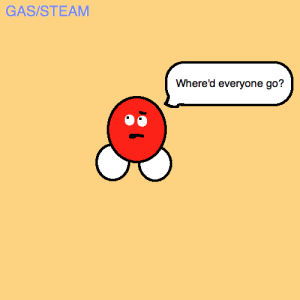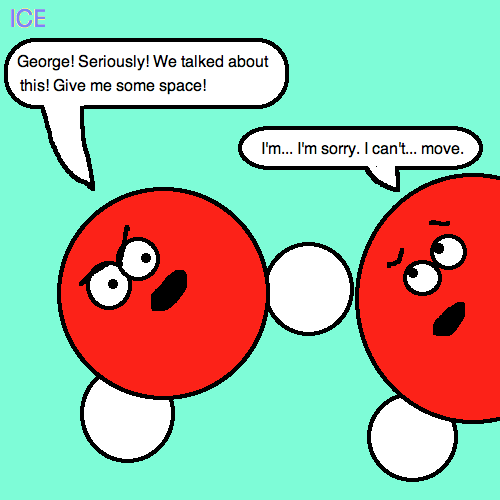The Importance of Being Snowflakes
A few days ago, I saw a window display with giant paper snowflake sculpture things (wow, I’m so descriptive). I reflected on the awesomeness that is water and it’s snowflake-making qualities. Water, I give thee props. You really mean a lot to me, and every other living thing.
As you probably already know, the H-two-O is made of hydrogen and oxygen.

These two atoms work very well together and get along quite swimmingly.

Two hydrogen atoms and one oxygen atom make the molecule that is known as water. It looks not unlike a Mickey Mouse head, but I’ll draw it upside down to lessen the mickey qualities. I want you to take water seriously.

The quality of this little molecule that gives it all its awesomeness is the fact that it’s polar: it has different charges at different ends. The oxygen end has a negative charge, and the hydrogen side has a positive charge.

When two water molecules come together, they experience a bit of attraction because of the positive and negative ends. This means that water is attracted to itself, like Colin Farrel.


Unless you’re a hermit living under a rock, you probably also know that water can exist as a few different states. (I suppose if you were an under-rock-living-hermit, surely you’d be internetless, so I should probably just assume you’re not a rock hermit. Is this parenthetical stream of consciousness too off topic? Sorry.)
Liquid water is liquid-y because the water molecules are flying around quickly like anarchists. This is what gives liquid water its shapelessness, or rather its propensity to take the shape of whatever you pour it in.
Flying around like mad might be fun for the water molecules, but it might also be terrifying. We’ll never really know for sure.

When water molecules are heated up (say, on my stove), it makes them move faster and faster. The chaos that ensues spreads the water molecules farther and farther apart. There is so much energy, they’re going insane. Eventually they move so fast that they overcome the air pressure that has been keeping them together, and they turn into steam.
In steam form (which sounds like something a superhero might yell when he calls upon his super power), the water molecules are spread very far apart. After a liquid existence, where water molecules are bumping into each other all the time, the drastic change might inspire loneliness.

On the flip side, when water cools down to an extreme, the water molecules slow down until they are almost not moving. As this happens, they become closer together and settle next to each other.

The lack of personal space is a bit controversial. But as they settle in, they start to form a hexagonal lattice structure. Here’s what it looks like with just the oxygen atoms drawn for simplicity.

Adding the hydrogen atoms to the drawing is tricky because I’m drawing a 3-dimensional structure in 2D. Some of the hydrogen atoms are sticking up, which I drew as a white circle on top of the red circle. And some of them are pointing down, in which case, I just didn’t draw it. Call it laziness, call it lack of x-ray vision. Whatever.

Solids tend to be denser than liquids, so you’d think that ice would sink in water, but it doesn’t. This is unusual. Ice is actually less dense than water because of this hexagonal crystal structure. Look at all that empty space!

If ice didn’t float on water, it’s likely that life couldn’t exist on earth. If ice sank, then the entire ocean could freeze over. Because ice floats, only a thin layer at the surface freezes, leaving plenty of space for life to exist and evolve. This is serious stuff. We owe our lives to ice… unless, that is, you are caught in an avalanche or blizzard… in which case, ice is not so nice.
The crystal structure of ice is also what gives snowflakes the chance to form. It’s a million ice crystals piled on top of each other, and the highly organized nature of ice’s structure can manifest in symmetrical, pretty snowflakes. It’s also no coincidence that we tend to draw 6-pointed snowflakes. That’s really how they look: it’s the macroscopic effect of the microscopic hexagonal crystal structure of ice. Woah.

Some people worship snowflakes by allowing them to land on their tongue. The proper alignment for this religious activity is shown below.




